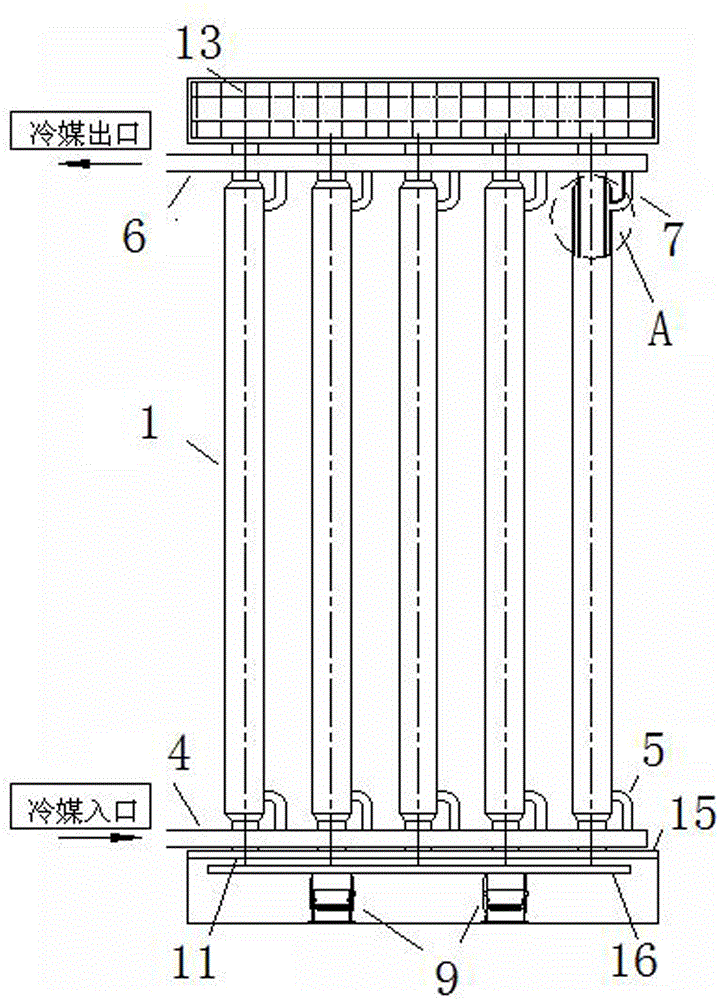Breezeless or gentle breeze air conditioner indoor unit
An air conditioner indoor unit and breeze technology, applied in the field of air conditioners, can solve the problems of high wind speed, low heat exchange efficiency, insufficient human comfort, etc., and achieve the effects of high thermal efficiency, avoiding human discomfort, rapid radiation and convection heat exchange
- Summary
- Abstract
- Description
- Claims
- Application Information
AI Technical Summary
Problems solved by technology
Method used
Image
Examples
Embodiment 1
[0030] No wind cooling mode. When the indoor unit of the air conditioner is in cooling operation, when the radiation heat transfer and natural convection heat transfer can meet the indoor cooling load demand, the indoor unit of the air conditioner operates in the windless cooling mode, which is generally applicable to the state where the temperature difference between indoor and outdoor is not high or sleeping.
[0031] Such as figure 1 As shown, five radiation convection heat exchange tubes are arranged side by side, the tops of the five radiation convection heat exchange tubes are connected to the air outlet structure, the air outlet direction is side air outlet, and the bottoms of the five radiation convection heat exchange tubes are connected to the return air structure. In each radiative convection heat exchange tube, the top and bottom of the inner tube are respectively connected with the air outlet and return air structures, and the first refrigerant main pipe is arrang...
Embodiment 2
[0034] Breeze cooling mode. When the indoor unit of the air conditioner is in cooling operation, when the radiation heat transfer and natural convection heat transfer are not enough to meet the indoor cooling load demand, the indoor unit of the air conditioner operates in the breeze cooling mode.
[0035] The indoor fan is turned on to run in the breeze mode, and the design of the air outlet of the indoor unit and the organization of the air flow are assisted, so that the indoor personnel can hardly feel the influence of the air-conditioning wind. The low-temperature refrigerant enters the indoor unit from the first refrigerant main pipe, and flows out of the indoor unit from the second refrigerant main pipe. The indoor unit of the air conditioner performs radiation and natural convection heat exchange to the indoor environment through the outer wall of the radiation convection heat exchange tube group, and the insufficient heat transfer part performs forced convection heat ex...
Embodiment 3
[0038] Powerful cooling mode. When the indoor unit of the air conditioner is in cooling operation, when the room needs to be cooled quickly with a large load, the indoor unit of the air conditioner operates in the strong cooling mode.
[0039] The indoor fan is turned on to run at high wind speed, and the fan is installed in the return air box of the return air structure. The low-temperature refrigerant enters the indoor unit from the first refrigerant main pipe, and flows out of the indoor unit from the second refrigerant main pipe. On the one hand, the indoor unit of the air conditioner performs radiation and natural convection heat exchange to the indoor environment through the outer wall of the radiation convection heat exchange tube group, and on the other hand, performs forced convection heat exchange on the fan airflow through the inner tube of the radiation convection heat exchange tube group. The condensed water on the outer wall of the radiation convection heat exch...
PUM
 Login to View More
Login to View More Abstract
Description
Claims
Application Information
 Login to View More
Login to View More - R&D
- Intellectual Property
- Life Sciences
- Materials
- Tech Scout
- Unparalleled Data Quality
- Higher Quality Content
- 60% Fewer Hallucinations
Browse by: Latest US Patents, China's latest patents, Technical Efficacy Thesaurus, Application Domain, Technology Topic, Popular Technical Reports.
© 2025 PatSnap. All rights reserved.Legal|Privacy policy|Modern Slavery Act Transparency Statement|Sitemap|About US| Contact US: help@patsnap.com



